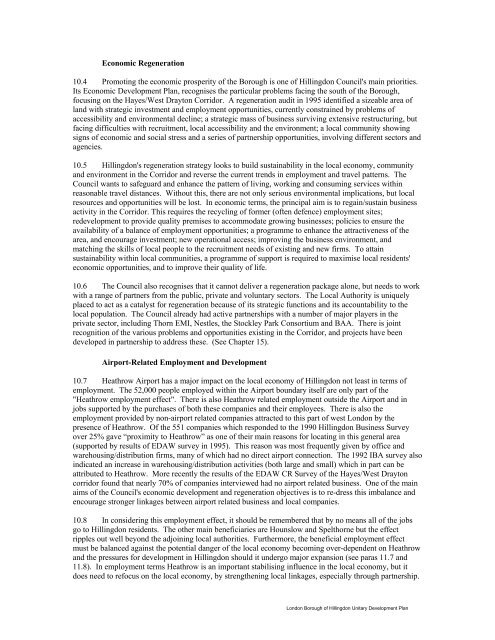HILLINGDON UNITARY DEVELOPMENT PLAN - London Borough ...
HILLINGDON UNITARY DEVELOPMENT PLAN - London Borough ...
HILLINGDON UNITARY DEVELOPMENT PLAN - London Borough ...
You also want an ePaper? Increase the reach of your titles
YUMPU automatically turns print PDFs into web optimized ePapers that Google loves.
Economic Regeneration<br />
10.4 Promoting the economic prosperity of the <strong>Borough</strong> is one of Hillingdon Council's main priorities.<br />
Its Economic Development Plan, recognises the particular problems facing the south of the <strong>Borough</strong>,<br />
focusing on the Hayes/West Drayton Corridor. A regeneration audit in 1995 identified a sizeable area of<br />
land with strategic investment and employment opportunities, currently constrained by problems of<br />
accessibility and environmental decline; a strategic mass of business surviving extensive restructuring, but<br />
facing difficulties with recruitment, local accessibility and the environment; a local community showing<br />
signs of economic and social stress and a series of partnership opportunities, involving different sectors and<br />
agencies.<br />
10.5 Hillingdon's regeneration strategy looks to build sustainability in the local economy, community<br />
and environment in the Corridor and reverse the current trends in employment and travel patterns. The<br />
Council wants to safeguard and enhance the pattern of living, working and consuming services within<br />
reasonable travel distances. Without this, there are not only serious environmental implications, but local<br />
resources and opportunities will be lost. In economic terms, the principal aim is to regain/sustain business<br />
activity in the Corridor. This requires the recycling of former (often defence) employment sites;<br />
redevelopment to provide quality premises to accommodate growing businesses; policies to ensure the<br />
availability of a balance of employment opportunities; a programme to enhance the attractiveness of the<br />
area, and encourage investment; new operational access; improving the business environment, and<br />
matching the skills of local people to the recruitment needs of existing and new firms. To attain<br />
sustainability within local communities, a programme of support is required to maximise local residents'<br />
economic opportunities, and to improve their quality of life.<br />
10.6 The Council also recognises that it cannot deliver a regeneration package alone, but needs to work<br />
with a range of partners from the public, private and voluntary sectors. The Local Authority is uniquely<br />
placed to act as a catalyst for regeneration because of its strategic functions and its accountability to the<br />
local population. The Council already had active partnerships with a number of major players in the<br />
private sector, including Thorn EMI, Nestles, the Stockley Park Consortium and BAA. There is joint<br />
recognition of the various problems and opportunities existing in the Corridor, and projects have been<br />
developed in partnership to address these. (See Chapter 15).<br />
Airport-Related Employment and Development<br />
10.7 Heathrow Airport has a major impact on the local economy of Hillingdon not least in terms of<br />
employment. The 52,000 people employed within the Airport boundary itself are only part of the<br />
"Heathrow employment effect". There is also Heathrow related employment outside the Airport and in<br />
jobs supported by the purchases of both these companies and their employees. There is also the<br />
employment provided by non-airport related companies attracted to this part of west <strong>London</strong> by the<br />
presence of Heathrow. Of the 551 companies which responded to the 1990 Hillingdon Business Survey<br />
over 25% gave “proximity to Heathrow” as one of their main reasons for locating in this general area<br />
(supported by results of EDAW survey in 1995). This reason was most frequently given by office and<br />
warehousing/distribution firms, many of which had no direct airport connection. The 1992 IBA survey also<br />
indicated an increase in warehousing/distribution activities (both large and small) which in part can be<br />
attributed to Heathrow. More recently the results of the EDAW CR Survey of the Hayes/West Drayton<br />
corridor found that nearly 70% of companies interviewed had no airport related business. One of the main<br />
aims of the Council's economic development and regeneration objectives is to re-dress this imbalance and<br />
encourage stronger linkages between airport related business and local companies.<br />
10.8 In considering this employment effect, it should be remembered that by no means all of the jobs<br />
go to Hillingdon residents. The other main beneficiaries are Hounslow and Spelthorne but the effect<br />
ripples out well beyond the adjoining local authorities. Furthermore, the beneficial employment effect<br />
must be balanced against the potential danger of the local economy becoming over-dependent on Heathrow<br />
and the pressures for development in Hillingdon should it undergo major expansion (see paras 11.7 and<br />
11.8). In employment terms Heathrow is an important stabilising influence in the local economy, but it<br />
does need to refocus on the local economy, by strengthening local linkages, especially through partnership.<br />
<strong>London</strong> <strong>Borough</strong> of Hillingdon Unitary Development Plan
















